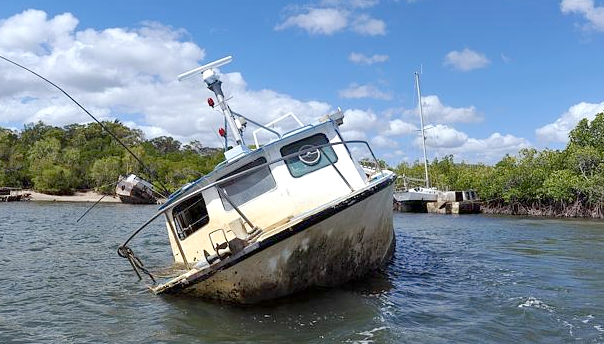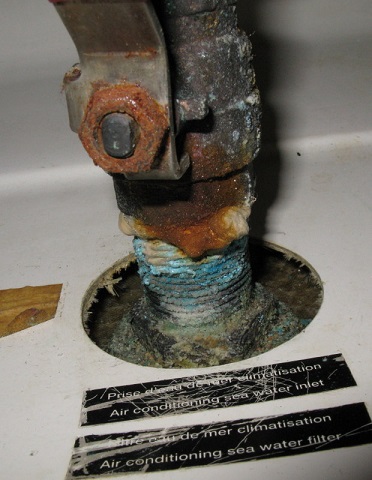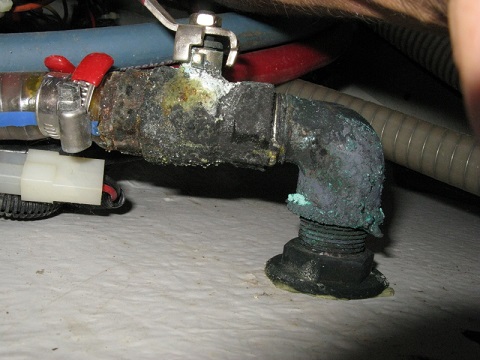
Boat Maintenance – THE PERILS OF MARINE PLUMBING and a few tips for staying afloat!
One easy way to sink your fibreglass boat is to neglect the skin-fittings and through-hull assemblies that allow water, vapour or waste to pass in or out through the hull. These assemblies are made up of relatively inexpensive components, all of which steadily degrade – and yet they are underestimated as a potential ‘sinker’ by the majority of boatowners. In the USA it is claimed that through-hull plumbing failures are the primary cause of pleasure boats sinking.
Inspecting vessels for insurance or pre-purchase surveys, we frequently encounter owners who pride themselves on maintaining their engines, steering systems, gelcoat and brightwork in tip-top condition; but when we get down in the bilges, we find their through-hull valves are seized and assembly fittings corroded to the point of collapse.
For those unfamiliar with pleasure boat plumbing, ‘skin-fittings’ (or ‘through-hulls’, as Americans call them) are the fittings that go through the hull itself. Skin-fittings come in various materials and configurations, but in Australia they are more often than not a threaded tube with external flange and a fastening nut on the inside of the hull. ‘Through-hull assembly’ refers to various fittings, such as valves (or ‘seacocks’), hosetails, pipes and elbows, which may be connected to the skin-fitting inside the boat.
Materials
Traditionally, marine plumbing components have been made of bronze. ‘Bronze’ is a non-specific word commonly-applied to a large spectrum of metal alloys. At the top end are some corrosion-resistant alloys that will last for years; but the word ‘bronze’ is more often used to up-sell household-quality brass. In the marine environment, brass can dezincify at a frightening speed. We’ve seen fittings crumble in the hand during an attempt to operate a valve or unscrew a component from the assembly.
Even quality bronze deteriorates under attack from galvanic and stray current, salt water and other corrosive solutions (such as holding tank waste). If your bronze plumbing fittings are black or spotty pink, and/or coated in heavy verdigris or crystalline deposits, heed the warnings – it’s time for some maintenance.
Stainless steel fittings are also used in Australia. Again, quality varies; but as a general rule, stainless steel is more prone to corrosion in a wet salty environment than a marine-grade bronze. Whether 304 or 316-grade, stainless steel is only corrosion-resistant so long as its surface is healthy and exposed to oxygen. Breach the surface layer (with a scratch, for example) and pitting corrosion can eat away at concealed faces of a stainless steel fitting, drastically reducing its strength in a relatively short time. We often hear people comment that below-waterline stainless steel fails ‘without warning’. Warning signs may well be present if you disassemble components, clean and inspect them carefully – but few boatowners are prepared to go to this trouble.
In some countries, polymeric (or ‘plastic’) plumbing fittings are available in a marine grade. On the downside, plastic fittings can suffer from brittleness and UV-degradation; and the plastic may not be resistant to fuel or other waste substances. Depending on size and quality, valves may be ‘flimsy’ compared to metal. Handles need ‘exercising’ regularly to stop them binding.
Nevertheless, given the issues commonly encountered with metal under water, polymeric fittings are an attractive alternative – especially for corrosive holding tank waste. On many occasions we have found a plastic valve operating smoothly, while a nearby metal valve of the same age is frozen and degraded.

But beware – as a general rule, plastic is a weaker material than metal, and unless a fitting is specifically designed for marine below-water use and approved by a reputable body such as the American Boat & Yacht Council (ABYC), it should be avoided. Approved fittings are not widely available in Australia; so many surveyors will condemn plastic plumbing components out of hand, and insist on them being replaced with metal.
Avoiding the perils
Identify and locate ALL of the skin-fittings and through-hull assemblies inside your boat. They are easy to find on the outside of the hull, but often get hidden in the bottom of a locker beneath piles of gear. The ones you don’t check regularly will inevitably cause you the most headaches!
Inspect all skin-fitting and assembly components regularly. (Note: in warmer waters, corrosion rates are accelerated, so frequency of inspection is even more important.) Scrape marine growth and paint away from external flanges, grills and intakes; and inspect surfaces for cracks, pitting or discoloration. Internally, clean surfaces of verdigris, salt deposits, or bilge gunk, so you can check for corrosion. If you have any doubts about a fitting, consult an expert – or replace the fitting.

© 2015 Niki Perryman, JM Marine Survey. Please note: this article is a brief guide, and is not intended to be a comprehensive overview on the many aspects of marine plumbing. An expert should be consulted regarding individual applications.
For more boating tips, as well as information on the yacht and powerboat surveys we carry out, visit JM Marine Survey at: www.mastermarinesurvey.com. Alternatively, please contact us direct on (phone) 0437 389 320 or (email) jmmarinesurvey@gmail.com.